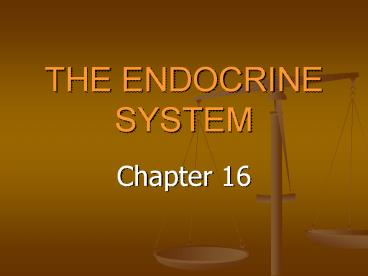THE ENDOCRINE SYSTEM - PowerPoint PPT Presentation
1 / 28
Title: THE ENDOCRINE SYSTEM
1
THE ENDOCRINE SYSTEM
- Chapter 16
2
OVERVIEW
- Group of unimpressive, discontinuous organs
- Coordinates and integrates body activity through
the use of hormones produced in - ductless glands
3
- Differs from nervous system because its work is
strictly chemical - Exocrine glands use ducts to deliver their
secretions
4
Organs
- Pineal, hypothalamus, pituitary, thyroid,
parathyroid, thymus, adrenal, pancreas, testis,
ovary, placenta, tumors, cells within the
digestive tract, heart, kidney, etc.
5
(No Transcript)
6
Adrenal
5
1
1
Pineal
Pituitary
1
2
Thyroid
2
Pancreas
6
3
Ovaries
8
4
9
Testes
Digestive hormones
7
Thymus
4
Hypothalamus
1
5
Parathyroid
3
6
7
8
9
7
tropic hormones
hypothalamus
thyroid-stimulating hormone (TSH)
antidiuretic hormone (ADH)
posterior pituitary
Thyroid gland
anterior pituitary
Kidney tubules
adrenocorticotropic hormone (ACTH)
oxytocin
Muscles of uterus
gonadotropic hormones follicle- stimulating horm
one (FSH) luteinizing hormone (LH)
melanocyte-stimulating hormone (MSH)
growth hormone (GH)
prolactin (PRL)
Adrenal cortex
Melanocyte in amphibian
Mammary glands in mammals
Bone and muscle
Ovary
Testis
8
Hormones
- Chemicals released into extracellular fluids that
regulate metabolic functions of other cells - Ex growth, development, metabolism immune
response, electrolyte water balance, blood
pressure, RBC production
9
- Hormones fall into one of 2 categories
- Amino-acid based most hormones in this
category ex thyroxine, insulin, melatonin, ADH,
etc. - Steroid- (cholesterol based) ex sex hormones
(estrogen, FSH, LH, testosterone), aldosterone
10
- Function by binding to and influencing activity
of a target cell (cell containing receptors for
that hormone) ex most body cells have receptors
for human growth hormone and thyroxine - Provoke a secondary messenger activity
- OR
- Directly influence DNA activity of the cell
11
- Once bound, hormones
- Change plasma membrane permeability
- Promote production of regulatory molecules
enzymes - Activate or deactivate enzymes
- Induce secretory activity of the cell
12
- Control is by feedback mechanism
- Ex Negative Feedback
- Gland is stimulated due to low levels of hormone
- Hormone is released
- Hormone levels
increase in
bloodstream - Increased levels
deactivate gland
13
Maintaining homeostasis
hormone 1
lowersbody condition
gland
specific body condition
raisesbody condition
gland
Negative FeedbackModel
hormone 2
14
Controlling Body Temperature
Nervous System Control
Feedback
nerve signals
brain
sweat
dilates surfaceblood vessels
body temperature
brain
shiver
constricts surfaceblood vessels
nerve signals
15
Regulation of Blood Sugar
Feedback
Endocrine System Control
insulin
body cells takeup sugar from blood
liver storessugar
reducesappetite
blood sugar level
liver releasessugar
triggershunger
glucagon
16
Blood Osmolarity
Feedback
Endocrine System Control
ADH
increasedwaterreabsorption
increasethirst
blood osmolarity blood pressure
increasedwater saltreabsorption
renin
aldosterone
angiotensin
17
Regulation of Blood Calcium
Feedback
Endocrine System Control
calcitonin
? kidney filters Ca
Ca depositedin bones
high
blood calcium level(10 mg/100mL)
? Ca uptakein intestines
low
activated Vitamin D
parathyroid
? kidney reabsorbs Ca
bones release Ca
PTH
18
Female reproductive cycle
Feedback
eggmatures is released(ovulation)
builds up uterus lining
estrogen
progesterone
fertilized egg
FSH LH
maintainsuterus lining
HCG
pregnancy
progesterone
GnRH
corpus luteum breaks down progesterone drops
menstruation
maintainsuterus lining
hypothalamus
19
- Control falls into one of 3 categories
- Hormonal stimuli Ex FSH from pituitary
stimulates ovary to release progesterone and
estrogen this in turn shuts down FSH rhythm
20
- Humoral stimuli Ex blood sugar levels
stimulate pancreas to release insulin this
lowers sugar levels which in turn reduces insulin
production
21
- Neural stimuli Ex stress triggers adrenal
gland to release adrenaline
22
- Organs/Hormones
- Anterior Pituitary HGH, TSH, ACTH, FSH, LH,
PRL - Hypothalamus oxytocin, ADH
- Thyroid thyroxine, calcitonin
- Parathyroid PTH
23
- Adrenal glucocorticoids, androgens,
aldosterone, adrenaline - Pancreas insulin, glucagon
- Gonads testosterone, estrogen, progesterone
- Pineal melatonin
- Thymus thymopoietin, thymosin
24
Goiter
- Iodine deficiency causes thyroid to enlarge as it
tries to produce thyroxine
25
Robert Wadlow 1918-1940 8' 11"
Excessive HGH
26
(No Transcript)
27
Hyperthyroidism
Graves - hyperthyroid
hypothyroidism
28
Cushings Disease































